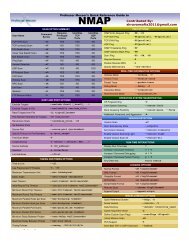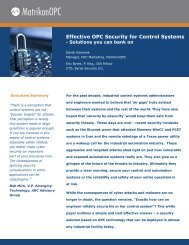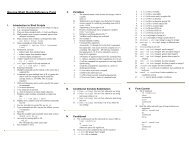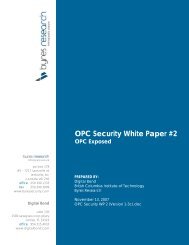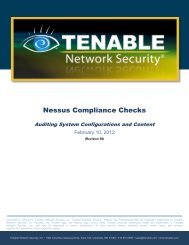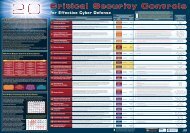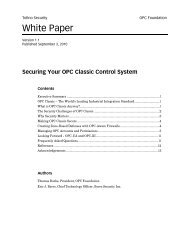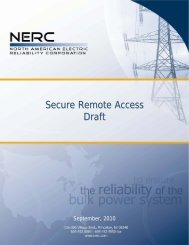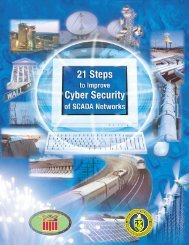Mapping between NIST 800-53 and ISO/IEC 27001 - SCADAhacker
Mapping between NIST 800-53 and ISO/IEC 27001 - SCADAhacker
Mapping between NIST 800-53 and ISO/IEC 27001 - SCADAhacker
Create successful ePaper yourself
Turn your PDF publications into a flip-book with our unique Google optimized e-Paper software.
Special Publication <strong>800</strong>-<strong>53</strong> Recommended Security Controls for Federal Information Systems <strong>and</strong> Organizations________________________________________________________________________________________________APPENDIX HINTERNATIONAL INFORMATION SECURITY STANDARDSSECURITY CONTROL MAPPINGS FOR <strong>ISO</strong>/<strong>IEC</strong> <strong>27001</strong>The mapping tables in this appendix provide organizations with a general indication ofsecurity control coverage with respect to <strong>ISO</strong>/<strong>IEC</strong> <strong>27001</strong>, Information technology–Securitytechniques–Information security management systems–Requirements. 76 <strong>ISO</strong>/<strong>IEC</strong><strong>27001</strong> applies to all types of organizations (e.g., commercial, government) <strong>and</strong> specifiesrequirements for establishing, implementing, operating, monitoring, reviewing, maintaining, <strong>and</strong>improving a documented information security management system (ISMS) within the context ofthe organization’s overall business risks. While the risk management approach established by<strong>NIST</strong> originally focused on managing risk from information systems (as required by FISMA <strong>and</strong>described in <strong>NIST</strong> Special Publication <strong>800</strong>-39), the approach is being exp<strong>and</strong>ed to include riskmanagement at the organizational level. A forthcoming version of <strong>NIST</strong> Special Publication <strong>800</strong>-39 will incorporate <strong>ISO</strong>/<strong>IEC</strong> <strong>27001</strong> to manage organizational information security risk throughthe establishment of an ISMS. Since <strong>NIST</strong>’s mission includes the adoption of international <strong>and</strong>national st<strong>and</strong>ards where appropriate, <strong>NIST</strong> intends to pursue convergence to reduce the burdenon organizations that must conform to both sets of st<strong>and</strong>ards. The convergence initiative will becarried out in three phases. Phase I, the subject of this appendix, provides a two-way mapping<strong>between</strong> the security controls in <strong>NIST</strong> Special Publication <strong>800</strong>-<strong>53</strong> <strong>and</strong> the controls in <strong>ISO</strong>/<strong>IEC</strong><strong>27001</strong> (Annex A). Phase II will provide a two-way mapping <strong>between</strong> the organization-level riskmanagement concepts in <strong>NIST</strong> Special Publication <strong>800</strong>-39 (forthcoming version) <strong>and</strong> generalrequirements in <strong>ISO</strong>/<strong>IEC</strong> <strong>27001</strong>. Phase III will use the results from Phase I <strong>and</strong> II to fullyintegrate <strong>ISO</strong>/<strong>IEC</strong> <strong>27001</strong> into <strong>NIST</strong>’s risk management approach such that an organization thatcomplies with <strong>NIST</strong> st<strong>and</strong>ards <strong>and</strong> guidelines can also comply with <strong>ISO</strong>/<strong>IEC</strong> <strong>27001</strong> (subject toappropriate assessment requirements for <strong>ISO</strong>/<strong>IEC</strong> <strong>27001</strong> certification).Table H-1 provides a forward mapping from the security controls in <strong>NIST</strong> Special Publication<strong>800</strong>-<strong>53</strong> to the controls in <strong>ISO</strong>/<strong>IEC</strong> <strong>27001</strong> (Annex A). The mappings are created by using theprimary security topic identified in each of the Special Publication <strong>800</strong>-<strong>53</strong> security controls <strong>and</strong>associated control enhancements (if any) <strong>and</strong> searching for a similar security topic in <strong>ISO</strong>/<strong>IEC</strong><strong>27001</strong> (Annex A). Security controls with similar functional meaning are included in the mappingtable. For example, Special Publication <strong>800</strong>-<strong>53</strong> contingency planning <strong>and</strong> <strong>ISO</strong>/<strong>IEC</strong> <strong>27001</strong>(Annex A) business continuity were deemed to have similar, but not the same, functionality. Insome cases, similar topics are addressed in the security control sets but provide a differentcontext, perspective, or scope. For example, Special Publication <strong>800</strong>-<strong>53</strong> addresses informationflow control broadly in terms of approved authorizations for controlling access <strong>between</strong> source<strong>and</strong> destination objects, whereas <strong>ISO</strong>/<strong>IEC</strong> <strong>27001</strong> (Annex A) addresses the information flow morenarrowly as it applies to interconnected network domains. Table H-2 provides a reverse mappingfrom the security controls in <strong>ISO</strong>/<strong>IEC</strong> <strong>27001</strong> (Annex A) to the security controls in SpecialPublication <strong>800</strong>-<strong>53</strong>. 7776 <strong>ISO</strong>/<strong>IEC</strong> <strong>27001</strong> was published in October 2005 by the International Organization for St<strong>and</strong>ardization (<strong>ISO</strong>) <strong>and</strong> theInternational Electrotechnical Commission (<strong>IEC</strong>).77 The use of the term XX-1 controls in mapping Table H-2 refers to the set of security controls represented by the firstcontrol in each family in <strong>NIST</strong> Special Publication <strong>800</strong>-<strong>53</strong>, where XX is a placeholder for the two-letter familyidentifier. These security controls primarily focus on policies <strong>and</strong> procedures for each topic area addressed by therespective security control family.APPENDIX H PAGE H-1



